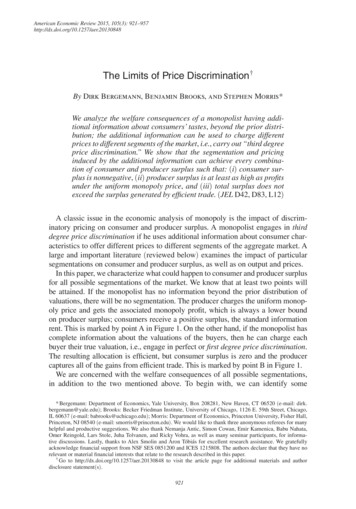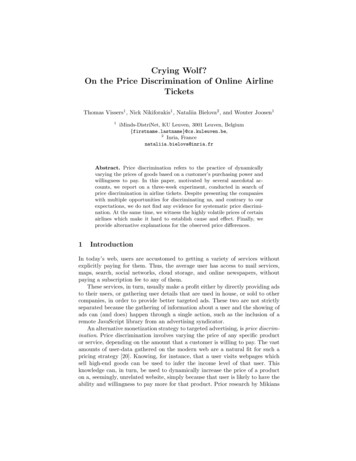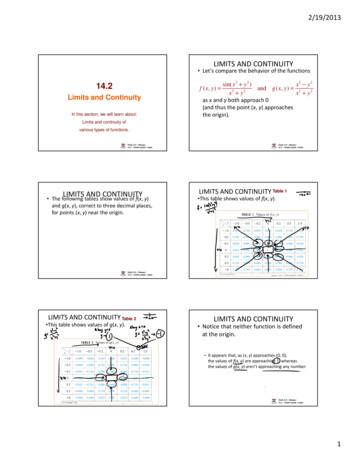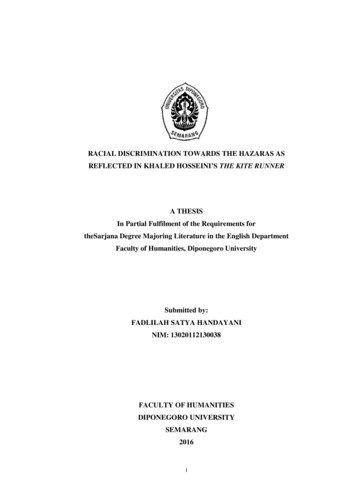
Transcription
American Economic Review 2015, 105(3): 921–957http://dx.doi.org/10.1257/aer.20130848The Limits of Price Discrimination †By Dirk Bergemann, Benjamin Brooks, and Stephen Morris *We analyze the welfare consequences of a monopolist having additional information about consumers’ tastes, beyond the prior distribution; the additional information can be used to charge differentprices to different segments of the market, i.e., carry out “third degreeprice discrimination.” We show that the segmentation and pricinginduced by the additional information can achieve every combination of consumer and producer surplus such that: (i) consumer surplus is nonnegative, (ii) producer surplus is at least as high as profitsunder the uniform monopoly price, and (iii) total surplus does notexceed the surplus generated by efficient trade. (JEL D42, D83, L12)A classic issue in the economic analysis of monopoly is the impact of discriminatory pricing on consumer and producer surplus. A monopolist engages in thirddegree price discrimination if he uses additional information about consumer characteristics to offer different prices to different segments of the aggregate market. Alarge and important literature (reviewed below) examines the impact of particularsegmentations on consumer and producer surplus, as well as on output and prices.In this paper, we characterize what could happen to consumer and producer surplusfor all possible segmentations of the market. We know that at least two points willbe attained. If the monopolist has no information beyond the prior distribution ofvaluations, there will be no segmentation. The producer charges the uniform monopoly price and gets the associated monopoly profit, which is always a lower boundon producer surplus; consumers receive a positive surplus, the standard informationrent. This is marked by point A in Figure 1. On the other hand, if the monopolist hascomplete information about the valuations of the buyers, then he can charge eachbuyer their true valuation, i.e., engage in perfect or first degree price discrimination.The resulting allocation is efficient, but consumer surplus is zero and the producercaptures all of the gains from efficient trade. This is marked by point B in Figure 1.We are concerned with the welfare consequences of all possible segmentations,in addition to the two mentioned above. To begin with, we can identify some* Bergemann: Department of Economics, Yale University, Box 208281, New Haven, CT 06520 (e-mail: dirk.bergemann@yale.edu); Brooks: Becker Friedman Institute, University of Chicago, 1126 E. 59th Street, Chicago,IL 60637 (e-mail: babrooks@uchicago.edu); Morris: Department of Economics, Princeton University, Fisher Hall,Princeton, NJ 08540 (e-mail: smorris@princeton.edu). We would like to thank three anonymous referees for manyhelpful and productive suggestions. We also thank Nemanja Antic, Simon Cowan, Emir Kamenica, Babu Nahata,Omer Reingold, Lars Stole, Juha Tolvanen, and Ricky Vohra, as well as many seminar participants, for informative discussions. Lastly, thanks to Alex Smolin and Áron Tóbiás for excellent research assistance. We gratefullyacknowledge financial support from NSF SES 0851200 and ICES 1215808. The authors declare that they have norelevant or material financial interests that relate to the research described in this paper.†Go to http://dx.doi.org/10.1257/aer.20130848 to visit the article page for additional materials and authordisclosure statement(s).921
922THE AMERICAN ECONOMIC REVIEWMarch 2015Producer surplus (π)BDACConsumer surplus (u)Figure 1. The Surplus Trianglee lementary bounds on consumer and producer surplus in any market segmentation.First, consumer surplus must be nonnegative as a consequence of the participationconstraint; a consumer will not buy the good at a price above his valuation. Second,the producer must get at least the surplus that he could get if there was no segmentation and he charged the uniform monopoly price. Third, the sum of consumerand producer surplus cannot exceed the total value that consumers receive from thegood, when that value exceeds the marginal cost of production. The shaded rightangled triangle in Figure 1 illustrates these three bounds.Our main result is that every welfare outcome satisfying these constraints isattainable by some market segmentation. This is the entire shaded triangle in Figure1. The point marked C is where consumer surplus is maximized; in particular, theproducer is held down to his uniform monopoly profits, but at the same time theoutcome is efficient and consumers receive all of the gains in efficiency relative tono discrimination. At the point marked D, social surplus is minimized by holdingproducer surplus down to uniform monopoly profits and holding consumer surplusdown to zero.We can explain these results most easily in the case where there is a finite set ofpossible consumer valuations and the cost of production is zero. The latter is merelya normalization of constant marginal cost we will maintain in the paper. We will firstexplain one intuitive way to maximize consumer surplus, i.e., realize point C. Theset of market prices will consist of every valuation less than or equal to the uniformmonopoly price. Suppose that we can divide the market into segments corresponding to each of these prices in such a way that (i) in each segment, the consumers’valuations are always greater than or equal to the price for that segment; and (ii) ineach segment, the producer is indifferent between charging the price for that segment and charging the uniform monopoly price. Then the producer is indifferent
VOL. 105 NO. 3BerGemann et al.: The Limits of Price Discrimination923to charging the uniform monopoly price on all segments, so producer surplus mustequal uniform monopoly profit. The allocation is also efficient, so consumers mustobtain the rest of the efficient surplus. Thus, (i) and (ii) are sufficient conditions fora segmentation to maximize consumer surplus.We now describe a way of constructing such a market segmentation iteratively.Start with a “lowest price segment” where a price equal to the lowest valuation willbe charged. All consumers with the lowest valuation go into this segment. For eachhigher valuation, a share of consumers with that valuation also enters into the lowestprice segment. While the relative share of each higher valuation (with respect toeach other) is the same as in the prior distribution, the proportion of all of the highervaluations is lower than in the prior distribution. We can choose that proportionbetween zero and one such that the producer is indifferent between charging the segment price and the uniform monopoly price. We know this must be possible becauseif the proportion were equal to one, the uniform monopoly price would be profitmaximizing for the producer (by definition); if the proportion were equal to zero—so only lowest valuation consumers were in the market—the lowest price would beprofit maximizing; and, by keeping the relative proportions above the lowest valuation constant, there is no price other than these two that could be optimal. Now wehave created one market segment satisfying properties (i) and (ii) above. But noticethat the consumers not put in the lowest price segment are in the same relative proportions as they were in the original population, so the original uniform monopolyprice will be optimal on this “residual segment.” We can apply the same procedureto construct a segment in which the market price is the second lowest valuation: putall the remaining consumers with the second lowest valuation into this market; forhigher valuations, put a fixed proportion of remaining consumers into that segment;choose the proportion so that the producer is indifferent between charging the second lowest valuation and the uniform monopoly price. This construction iteratesuntil the segment price reaches the uniform monopoly price, at which point we haverecovered the entire population and point C is attained.For the formal proof of our results, we make use of a deeper geometric argument. This establishes an even stronger conclusion: any point where the monopolist is held down to his uniform monopoly profits—including outcomes A, C,and D in Figure 1—can be achieved with the same segmentation! In this segmentation, consumer surplus varies because the monopolist is indifferent betweencharging different prices. A geometric property is key to the existence of such asegmentation. Consider the set of all markets where a given monopoly price isoptimal. This set is convex, so any aggregate market with the given monopolyprice can be decomposed as a weighted sum of markets which are extreme pointsof this set, which in turn defines a segmentation. We show that these extremepoints, or extremal markets, must take a special form: in any extremal market, the monopolist will be indifferent to setting any price in the support of consumers’valuations. Thus, each subset of valuations that includes the given monopoly pricegenerates an extremal market. If the monopolist charges the uniform monopolyprice on each extreme segment, we get point A. If he charges the lowest value inthe support of each segment (which is also an optimal price, by construction), weget point C; and if he charges the highest value in the support, we get point D.Beyond its welfare implications, this argument also highlights the multiplicity of
924THE AMERICAN ECONOMIC REVIEWMarch 2015segmentations that can achieve extreme outcomes, since there are many sets ofextremal markets which can be used to decompose a given market.Thus, we are able to demonstrate that points B, C, and D can be attained. Everypoint in the shaded triangle in Figure 1 can also be attained, by segmenting a shareof the market using extremal markets as in the previous paragraph and segmentingthe rest of the market to facilitate perfect price discrimination. Such a segmentationalways gives a fixed level of producer surplus between the uniform monopoly profitand perfect price discrimination profit, and the monopolist is indifferent betweenprices that yield a consumer surplus of zero and prices that maximize social surplus.This gives us a complete characterization of all possible welfare outcomes.While we focus on welfare implications, we can also completely characterizepossible output levels and derive implications for prices. An upper bound on outputis the efficient quantity, and this is realized by any segmentation along the efficientfrontier. In particular, it is attained in any consumer surplus maximizing segmentation. In such segmentations, prices are always weakly below the uniform monopolyprice. We are also able to obtain a tight lower bound on output. Note that in anysegmentation, the monopolist must receive at least his uniform monopoly profits, sothis profit is a lower bound on social surplus. We say that an allocation is conditionally efficient if conditional on the good being sold, it is sold to those with the highestvaluations. Such allocations minimize output for a given level of social surplus. Infact, we construct a social surplus minimizing segmentation that results in a conditionally efficient allocation and therefore attains a lower bound on output. In thissegmentation, and indeed in any social surplus minimizing segmentation, prices arealways weakly higher than the uniform monopoly price.Though the results described above are for discrete distributions, we are able toprove similar results for continuous demand functions and, more generally, anymarket that can be described by a Borel measure over valuations. For such distributions, we use a limit argument to establish the existence of segmentations thatattain points C and D.We contribute to a large literature on third degree price discrimination, startingwith the classic work of Pigou (1920). This literature examines what happens toprices, quantity, consumer surplus, producer surplus, and social welfare as a market is segmented. Pigou considered the case of two segments with linear demand.In the special case where both segments are served when there is a uniform price,he showed that output does not change under price discrimination. Since different prices are charged in the two segments, this means that some high valuation consumers are replaced by low valuation consumers, and thus social welfaredecreases. We can visualize the results of Pigou and other authors in Figure 1.Pigou showed that this particular segmentation resulted in a west-northwest move(i.e., a move from point A to a point below the negative 45 line going throughA). A literature since then has focused on identifying sufficient conditions onthe shape of demand for social welfare to increase or decrease with price discrimination. A recent paper of Aguirre, Cowan, and Vickers (2010) unifies andextends this literature and, in particular, identifies sufficient conditions for pricediscrimination to either increase or decrease social welfare (i.e., move above orbelow the negative 45 line through A). Restricting attention to market segmentsthat have concave profit functions and an additional property (“increasing ratio
VOL. 105 NO. 3BerGemann et al.: The Limits of Price Discrimination925condition”) that they argue is commonly met, they show that welfare decreasesif the direct demand in the higher priced market is at least as convex as that inthe lower priced market; welfare is higher if prices are not too far apart and theinverse demand function in the lower priced market is locally more convex thanthat in the higher priced market. They note how their result ties in with an intuition of Robinson (1933): concave demand means that price changes have a smallimpact on quantity, while convex demand means that prices have a large impact onquantity. If the price rises in a market with concave demand and falls in a marketwith convex demand, the increase in output in the low-price market will outweighthe decrease in the high-price market, and welfare will go up. A recent paper ofCowan (2013) gives sufficient conditions for consumer surplus (and thus totalsurplus) to increase under third degree price discrimination.Our paper also gives sufficient conditions for particular welfare impacts of segmentation. However, unlike most of the literature, we allow for segments withnon-concave profit functions. Indeed, the segmentations giving rise to extremepoints in welfare space (i.e., consumer surplus maximization at point C and socialsurplus minimization at point D) generally rely on non-concave profit functionswithin segments. This ensures that the type of local conditions highlighted in theexisting literature will not obtain. Our non-local results suggest some very differentintuitions. Of course, consumer surplus always increases if prices drop in all markets. We show that for any demand curve, low valuation consumers can be pooledwith high valuation consumers in such a way that the producer has an incentive tooffer prices below the monopoly price; but if this incentive is made arbitrarily weak,the consumers capture the efficiency gains.The price discrimination literature also has results on the impact of segmentation on output and prices. With regard to output, the focus of this literature is onidentifying when an increase in output is necessary for an increase in welfare, as inSchmalensee (1981) and Varian (1985). Although we do not analyze the question indetail in this paper, a given output level is associated with many different levels ofproducer, consumer, and social surplus. We do provide a sharp characterization of thehighest and lowest possible output over all market segmentations. On prices, Nahata,Ostaszewski, and Sahoo (1990) offer examples with non-concave profit functionswhere third degree price discrimination may lead prices in all market segments tomove in the same direction; it may be that all prices increase or all prices decrease. Weshow that one can create such segmentations for any demand curve. In other words, inconstructing our critical market segmentations, we show that it is always possible tohave all prices rise or all prices fall (although profit functions in the segments cannotall be strictly concave, as shown by Nahata, Ostaszewski, and Sahoo 1990).If market segmentation is exogenous, one might argue that the segmentations thatdeliver extremal surpluses are special and might be seen as atypical. But given theamount of information presently being collected on the Internet about consumervaluations, it might be argued that there is increasing endogeneity in the marketsegmentations that arise. To the extent that producers control how information isdisseminated, they will have an incentive to gather as much information as possible,ideally engaging in perfect price discrimination. Suppose, however, that an Internetintermediary wanted to release its information about consumers to producers for freein order to maximize consumer welfare, say, because of regulatory pressure or as
926THE AMERICAN ECONOMIC REVIEWMarch 2015part of a broader business model. Our results describe how such a consumer-mindedInternet company would choose to structure this information.1Third degree price discrimination is a special case of the classic screening problem,in which a principal is designing a contract for an agent who has private informationabout the environment. In third degree price discrimination, the gross utility functionof the agent is the product of this willingness to pay for the object and the probabilityof receiving the good. An important observation due to Riley and Zeckhauser (1983)is that as long as consumers’ valuations are linear in the quantity, quality, or probability of getting the object, a posted price is an optimal mechanism. This would no longerbe true if valuations are nonlinear in quantity as in Maskin and Riley (1984) or inquality as in Mussa and Rosen (1978). In Section IV, we examine the robustness of ourresult by adding a small amount of concavity to consumers’ valuations. In this case,the marginal value of the good to each consumer varies with quantity, as in Maskinand Riley. As such, the monopolist will wish to engage in second degree price discrimination, in which consumers are screened through the use of a menu of quantity pricebundles. In the nonlinear screening environment, welfare bounds can be constructedin a manner analogous to the linear environment of third degree price discrimination.If the principal has no information about the agent’s type, then he must offer the samemenu to all agents, which yields a uniform menu profit (or producer surplus) for theprincipal with a corresponding information rent (or consumer surplus) for the agent,leading to a point analogous to A in Figure 1. If the principal was perfectly informedabout the agent’s type, he could extract all the potential surplus from the relationship,leading to point analogous to B in Figure 1. And, as in the third degree price discrimination problem, there are bounds on surplus pairs for any intermediate segmentationgiven by a triangle BCD. However, it is not possible in general to find a segmentationthat attains every point in BCD, and we do not have a characterization of what happensin general screening problems. In an illustrative example with binary types and a continuum of allocations, we do show that as we approach the linear case, the equilibriumsurplus pairs converge to the triangle and, in this sense, our main result is robust tosmall deviations from linearity.Our work has a methodological connection to two strands of literature. Kamenicaand Gentzkow’s (2011) study of “Bayesian persuasion” considers how a sender wouldchoose to transmit information to a receiver, if he could commit to an informationrevelation strategy before observing his private information. They provide a characterization of such optimal communication strategies as well as applications. If we let thereceiver be the producer choosing prices, and let the sender be a planner maximizingsome weighted sum of consumer and producer surplus, our problem belongs to theclass of problems analyzed by Kamenica and Gentzkow. They show that if one plotsthe utility of the “sender” as a function of the distribution of the sender’s types, hishighest attainable utility can be read off from the “concavification” of that function.2The concavification arguments are especially powerful in the case of two types. While1An important subtlety of this story, however, is that this could only be done by randomly allocating consumerswith the same valuation to different segments with different prices. Thus, it could be done by a benevolent intermediary who already knew consumers’ valuations, but not by one who needed consumers to truthfully report their values.2Aumann and Maschler (1995) show that the concavification of the (stage) payoff function represents the limitpayoff that an informed player can achieve in a repeated zero sum game with incomplete information. In particular, theirLemma 5.3, the “splitting lemma,” derives a partial disclosure strategy on the basis of a concavified payoff function.
VOL. 105 NO. 3BerGemann et al.: The Limits of Price Discrimination927we do not use concavification arguments in the proof of our main result, we illustratetheir use in our two type analysis of second degree price discrimination.Bergemann and Morris (2014, 2013) examine the general question, in strategicmany-player settings, of what behavior could arise in an incomplete informationgame if players observe additional information not known to the analyst. They showthat behavior that might arise is equivalent to an incomplete information version ofcorrelated equilibrium termed “Bayes correlated equilibrium,” which reduces to theproblem of Kamenica and Gentzkow (2011) in the case of one player and no initialinformation.3 Using the language of Bergemann and Morris, the present paper considers the game of a producer making take-it-or-leave-it offers to consumers. Here,consumers have a dominant strategy to accept all offers strictly less than their valuation and reject all offers strictly greater than their valuation, and we select for equilibria in which consumers accept offers that make them indifferent. We characterizewhat could happen for any information structure that players might observe, as longas consumers know their own valuations. Thus, we identify possible payoffs of theproducer and consumers in all Bayes correlated equilibria of the price setting game.In sum, our results are a striking application of the methodologies of Bergemann andMorris (2014, 2013) and Kamenica and Gentzkow (2011) to the problem of pricediscrimination. We also make use of these methodologies as well as results from thepresent paper in our analysis of what can happen for all information structures in afirst-price auction, in Bergemann, Brooks, and Morris (2013a).We present our model of monopoly price discrimination with discrete valuationsin Section I, with our main results in Section II. We first give a characterizationof the attainable surplus pairs using the extremal segmentations described above.Though the argument for this characterization is non-constructive, we also exhibitsome constructive approaches to achieve extreme welfare outcomes. In this section,we also characterize a tight lower bound on output that can arise under price discrimination. In Section III, we briefly extend our results to general settings with acontinuum of values, so that the demand curve consists of a combination of masspoints and densities. The basic economic insights extend to this setting unchanged.In Section IV, we briefly describe how our results change as we move to more general screening environments, where the utility of the buyer and/or the cost of theseller are not linear in quantity, and thus give rise to second degree price discrimination. We conclude in Section V. Omitted proofs for Sections II and III are containedin the print Appendix at the end, and an online Appendix contains detailed calculations for the model of Section IV.I. ModelA monopolist sells a good to a continuum of consumers, each of whom demandsone unit. We normalize the total mass of consumers to one and the constant marginalcost of the good to zero.4 There are K possible values V { v1 , , vk , , vK } ,3In Bergemann and Morris (2013), these insights were developed in detail in games with a continuum of players,linear-quadratic payoffs and normally distributed uncertainty.4The assumption of zero marginal cost is without loss of generality: after normalizing vˆ max { v c, 0} , allthe results apply verbatim to the net social value vˆ .
928March 2015THE AMERICAN ECONOMIC REVIEWwith vk 핉 , that the consumers might have, which without loss of generality areincreasing in the index k : 0 v1 vk vK . We will extend the analysis to a continuum of valuations in Section III. A market x is a distribution over the K valuations, with the set of all markets being: {K} X Δ(V) x 핉 V x ( vk ) 1 . k 1This set can be identified with the (K 1) -dimensional simplex, and to simplifynotation we will write x k for x ( vk ) , which is the proportion of consumers who haveK j k x j valuation vk . Thus, a market x corresponds to a step demand function, where is the demand for the good at any price in the interval ( v k 1 , vk ] (with the conventionthat v 0 0 ).While we will focus on this interpretation of the model throughout the paper, thereis a well-known alternative interpretation that there is a single consumer with unitdemand whose valuation is distributed according to the probability distribution x .The analysis is unchanged, and all of our results can be translated into this alternative interpretation.Throughout the analysis, we hold a given aggregate market as fixed and identifyit by x X . We say that the price vk is optimal for market x if the expected revenue from price vk satisfiesKKj kj i v k x j vi x j , for all i 1, , K. X k denotes the set of markets where price v k is optimal:{ KKj kj i X k x X vk x j vi x j , for all}i 1, , K . Now write v v i for the optimal uniform price for the aggregate market x . Thus, x X X i . The maximum feasible surplus isK w v j x j , j 1
VOL. 105 NO. 3BerGemann et al.: The Limits of Price e 2. The Simplex of Markets with vk {1, 2, 3} which corresponds to all consumers buying the good. The uniform price producersurplus is thenKK π v x j max vk x j k 1, , Kj i j kand the uniform price consumer surplus isK u ( v j v ) x j . j i We will use a simple example to illustrate many of the results to follow.Example 1 (Three Values with Uniform Probability): There are three valua 3 , vk k , andtions V { 1, 2, 3} , which arise in equal proportions. Thus, K x ( 1/3, 1/3, 1/3) . The feasible social surplus is w (1/3) (1 2 3) 2 .The uniform monopoly price is v i 2 . Under the uniform monopoly price,profit is π (2/3) 2 4/3 and consumer surplus is u (1/3) (3 2) (1/3) (2 2) 1/3 .We can graphically depict markets consisting of three possible valuations usinga classic visualization (see Mas-Colell et al. 1995, p. 169). A market is a point inthe two-dimensional probability simplex, which forms a triangular plane in three- dimensional Euclidean space, as depicted in the left panel of Figure 2. This set canbe projected onto two-dimensional Euclidean space as an equilateral triangle, as in
930March 2015THE AMERICAN ECONOMIC REVIEWthe right panel of Figure 2, and we will use this equilateral triangle projection inour subsequent graphical depictions of the example. The extreme points denoted by x {k} correspond to markets which put mass 1 on valuation k , and each point in thetriangle can be decomposed as a weighted sum of the three vertices with weightscorresponding to the respective proportions. Thus, the market x ( x 1 , x 2 , x 3) isrepresented as the point x 1 · x {1} x 2 · x {2} x 3 · x {3} . For example, the uniformmarket x (1/3, 1/3, 1/3) just discussed is the point equidistant from the threevertices, since it contains equal shares of each valuation.In the right panel, we have further divided the simplex into the three regions X 1 , X 2 , and X 3 where prices 1 , 2 , and 3 are respectively optimal. Note that the restrictionthat revenue from price vk is greater than revenue from price vi is a linear restrictionon markets, and thus the region X 1 , for example, is the intersection of the regionin which price 1 is better than 2 and the region where price 1 is better than 3 . Notealso that the linear projection from the simplex in 핉 3 onto the equilateral triangle in 핉 2 maps linear constraints on markets into half-planes, so that each region X k is theintersection of the triangle with two half-planes. A price of 2 is strictly optimal for 2 .the uniform market x , which therefore lies on the interior of XA segmentation is a division of the aggregate market into different markets. Thus,a segmentation σ is a simple probability distribution on X , with the interpretationthat σ (x) is the proportion of the population in market x . A segmentation can beviewed as a two-stage lottery on outcomes in V whose reduced lottery is x . Writingsupp for the support of a distribution, the set of possible segmentations is{ }Σ σ (X) σ(x) · x x , supp σ .x supp σ We restrict attention to finitely many segments so that supp σ . This is withoutloss of generality in the pres
The resulting allocation is efficient, but consumer surplus is zero and the producer captures all of the gains from efficient trade. This is marked by point B in Figure 1. . THE LIMITS OF PRICE DISCRIMINATION 923 to charging the uniform monopoly price on all segments, so producer surplus must equal uniform monopoly profit. The allocation is .










